Shipyard Employment eTool
Fire Protection >> Fire Response

Response to fire in the shipyard may be conducted by an internal fire department, an outside (local) fire response organization, or a combination of both. Requirements vary depending on the employer's choice for response.
- Fire response
- Internal fire department
- Training. See Fire Protection: Training for specific requirements.

Potential Hazards
- Inadequate communication between responsible parties.
- Lack of coordination when developing the program.
- Alarms may not be heard in remote or high noise areas.
- Lack of coordination during an event.
- Lack of accountability for workers after evacuation occurs.
- Local fire department has not evaluated facility.
- Incompatibility of local fire department equipment with facilities.
- Failure to locate utility shutoffs.
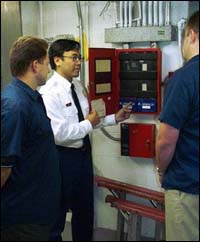
Requirements and Example Solutions
- The following type of fire response must be decided upon and implemented by the employer: [1915.505(a)]
- What type of response will be provided and who will provide it. [1915.505(a)(1)]
- Create, maintain, and update a written policy that: [1915.505(a)(2)]
- Describes the internal and outside fire response organizations that the employer will use. [1915.505(a)(2)(i)]
- Defines what evacuation procedures employees must follow if the employer chooses to require a total or partial evacuation of the worksite at the time of a fire. [1915.505(a)(2)(ii)]
-
Internal fire response. If an internal fire response is to be used, the written policy must include: [1915.505(b)(1)]

- Basic structure of the fire response organization. [1915.505(b)(1)(i)]
- Number of trained fire response employees. [1915.505(b)(1)(ii)]
- Fire response functions that may need to be carried out. [1915.505(b)(1)(iii)]
- Minimum number of fire response employees necessary, number and types of apparatuses, and a description of the fire suppression operations established by written standard operating procedures for each type of fire response at the employer's facility; [1915.505(b)(1)(iv)]
- Type, amount, and frequency of training that must be given to fire response employees; and [1915.505(b)(1)(v)]
- Procedures for using protective clothing and equipment. [1915.505(b)(1)(vi)]
-
Outside fire response. If an outside fire response organization is used, the written policy must include: [1915.505(b)(2)]
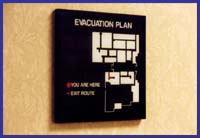
- Types of fire suppression incidents to which the fire response organization is expected to respond at the employer's facility or worksite. [1915.505(b)(2)(i)]
- Liaisons between the employer and the outside fire response organizations. [1915.505(b)(2)(ii)]
- A plan for fire response functions that: [1915.505(b)(2)(iii)]
- Addresses procedures for obtaining assistance from the outside fire response organization. [1915.505(b)(2)(iii)(A)]
- Familiarizes the outside fire response organization with the layout of the employer's facility or worksite, including access routes to controlled areas, and site-specific operations, occupancies, vessels or vessel sections, and hazards. [1915.505(b)(2)(iii)(B)]
- Explain how hose and coupling connection threads are to be made compatible and includes where the adapter couplings are kept. [1915.505(b)(2)(iii)(C)]
- Includes a statement that the employer will not allow the use of incompatible hose connections. [1915.505(b)(2)(iii)(D)]
-
If a combination of internal and outside fire response is to be used, the written policy must include the following requirements in addition to those outlined for the internal fire response requirements: [1915.505(b)(3)]

- Basic organizational structure of the combined fire response. [1915.505(b)(3)(i)]
- Number of combined trained fire responders. [1915.505(b)(3)(ii)]
- Fire response functions that may need to be carried out. [1915.505(b)(3)(iii)]
- Minimum number of fire response employees necessary, number and types of apparatuses, and a description of the fire suppression operations established by written standard operating procedures for each particular type of fire response at the worksite. [1915.505(b)(3)(iv)]
- Type, amount, and frequency of joint training with outside fire response organizations if given to fire response employees. [1915.505(b)(3)(v)]
- Employee evacuation. The employer's written policy must include: [1915.505(b)(4)]
- Emergency escape procedures. [1915.505(b)(4)(i)]
- Procedures to be followed by employees who may remain longer at the worksite to perform critical operations during the evacuation. [1915.505(b)(4)(ii)]
- Procedures to account for all employees after emergency evacuation is completed. [1915.505(b)(4)(iii)]
- The preferred means of reporting fires and other emergencies. [1915.505(b)(4)(iv)]
- Names or job titles of the employees or departments to be contacted for further information or explanation of duties. [1915.505(b)(4)(v)]
- Rescue and emergency response. The employer's written policy must include: [1915.505(b)(5)]
- A description of the emergency rescue procedures. [1915.505(b)(5)(i)]
- Names or job titles of the employees who are assigned to perform procedures. [1915.505(b)(5)(ii)]
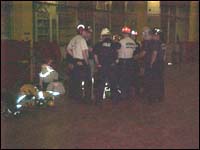
- Conduct joint drills with shipyard personnel and local fire department (Figure 7).
- Invite local fire department to tour vessels.
- Compile an emergency call list for quick contact in a fire event.
- Discuss fire response plan with personnel living on board vessels.
- Designate subcontractor supervisors to be accountable for workers during evacuations.
- Designate workers to visually verify that areas have been evacuated when alarm sounds for quick accountability.
- Use visual alarms for high noise areas.
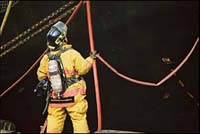
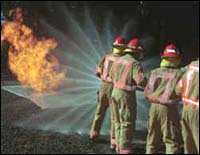
Shipyard internal fire departments will encounter the same hazards as any outside fire department. These hazards include:
- extreme heat
- burns
- smoke
- falls
Requirements and Example Solutions
- Medical requirements for shipyard fire response workers must include: [1915.505(c)]
- All fire response workers receive medical examinations to assure that they are physically and medically fit for the duties they are expected to perform. [1915.505(c)(1)]
- Fire response workers, who are required to wear respirators in performing their duties, meet the medical requirements of 1915.154. [1915.505(c)(2)]
- Each fire response employee has an annual medical examination. [1915.505(c)(3)]
- The medical records of fire response employees are kept in accordance with 1915.1020. [1915.505(c)(4)]

